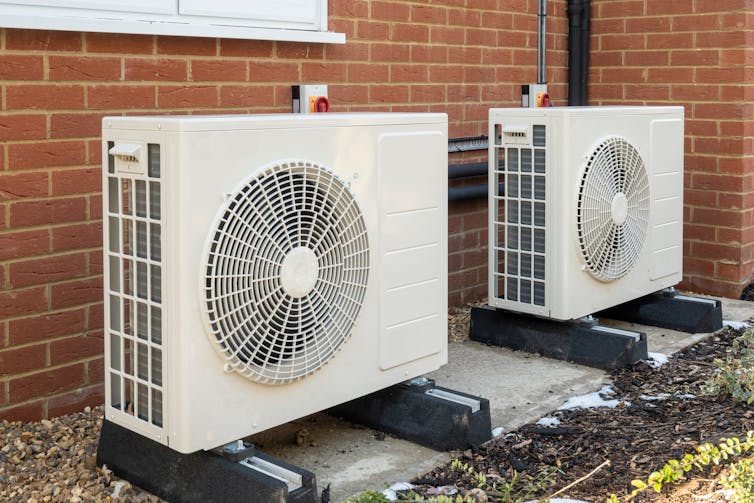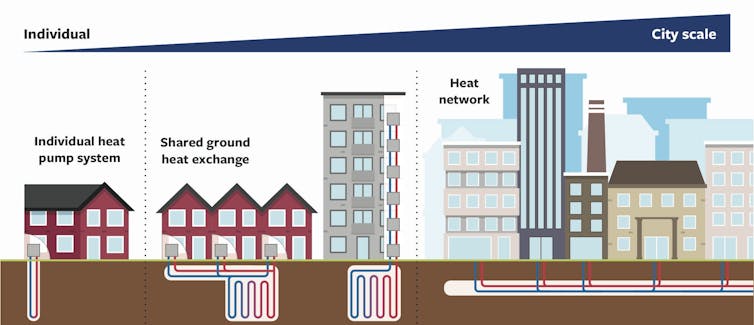Here’s how your whole street could get off gas heating

A blog post by David Barns, PhD researcher and Research Assistant in Shared Ground Heat Exchange Policy
From spiralling fossil fuel prices and volatile supply chains to the worsening climate crisis, there has never been a better time to stop heating homes with natural gas. The UK has the chance to replace as many gas boilers as possible before another winter of punishing heating bills descends. But if, like me, you long to keep your house warm and comfortable while keeping costs as low as possible, it can be difficult to know what the best solution is.
Replacing a gas boiler with a heat pump is a good solution for many homes. Like a fridge in reverse, heat pumps take energy from either the air or ground and run a compressor using electricity to turn this into heat and hot water.
But what if you lack the outside space necessary, like residents of many terraced houses or apartments? Ground source heat pumps need some space for a borehole or a horizontal trench, while air source heat pumps are best installed where their noise won’t disturb those who like to keep windows open at night. An alternative is a district heat network, which channels waste heat from power stations or other industrial sources to homes and businesses, but they are most useful in dense urban areas where people live close to large sources of heat.
Shared ground heat exchange is another heating system you’re less likely to have heard of, but one report suggests it could be eligible in 80% of UK homes. In common with ground source heat pumps, a shared ground heat exchange uses electricity to turn low-grade heat from boreholes into a cosy home with plenty of hot water. A street which had recently installed a shared ground heat exchange would show no sign of it, but each home would be connected to a set of shared boreholes that draw heat from the ground.
These can be installed well away from the houses and linked to them through a pipe running under the pavement. This gets around the need for each home to have outside space. Instead, each house would need a small heat pump of a similar size to a conventional gas boiler, which should fit snugly under most staircases or in an airing cupboard.
Shared ground heat exchanges can also return heat to the ground in summer, where it can be extracted later in the year, cutting the size and cost of installation.

If you want to replace your gas boiler with a heat pump, it’s typically your responsibility to instigate the work and fund the installation. This can prevent households low on time and money from making the switch to low-carbon heating.
Accessing a shared ground heat exchange could instead work a lot like signing up for broadband. A provider would install and operate the system, and as a household, you’d decide when you’re ready to ditch your boiler and connect. You would pay the operator a connection fee and then pay for heat through a normal electricity bill.
Allowing households the chance to connect when they choose without taking on any work themselves could deliver a much faster uptake of low-carbon heating. For instance, 8.5 million homes could enjoy heating supplied by energy from boreholes by 2050, compared to 2.1 million in current projections.

What’s the catch?
There are issues which need to be worked out for shared ground heat exchange to take off on a significant scale, but none of these are insurmountable.
There are currently only a few companies installing shared ground heat exchange in the UK, and installation costs remain high. This should change once new providers start to recognise the advantages this technology offers for decarbonising lots of home heating systems quickly.
If a company is to invest in drilling the boreholes and installing the pipework, they (and, importantly, their investors) will need to know that money will be repaid over time. This may mean it’s best for whole streets to join at the same time, requiring coordination, possibly by local authorities.
Shared ground heat exchange also suffers from a lack of awareness among national and local policymakers. Recent work from the Leeds and Leeds Beckett universities is aimed at addressing this gap.
Heat pumps and district heat networks are great in the right settings. As a combination of the two, and with the right support, shared ground heat exchange could help more households decarbonise their heating and hot water and stop relying on the imported gas which is inflating their bills.
This article is republished from The Conversation under a Creative Commons license. Read the original article.
